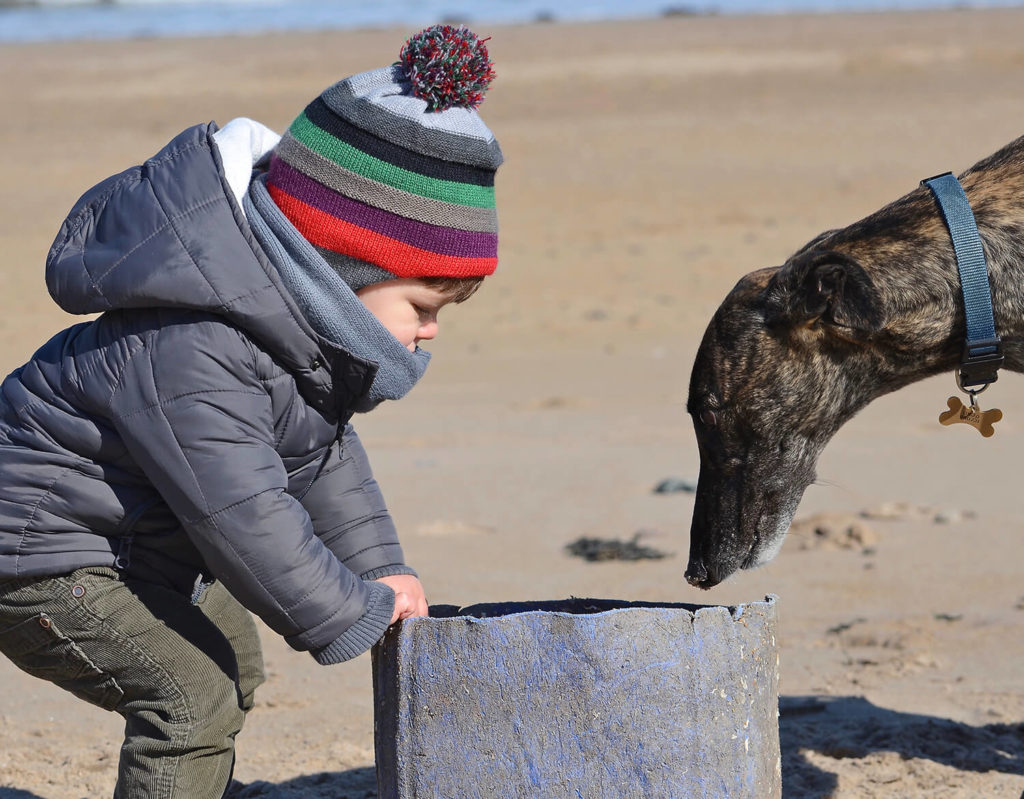Two years ago …
I am writing this at my parents’ home in Scotland. I am sitting in the room which used to be my bedroom. It is now a study. And as I look around, all I can see is stories.
For example, I can see the hole in the door which was caused by my competitive little brother on the day I beat him at Street Fighter II. I think he was having a bad week and, upon losing, he kicked the door and put his foot through it. Although he eventually matured into the laid-back young man that he is today, I remember that we gave him the nickname John McEnroe because he hated losing so much. He got into big trouble for making that hole. But I always like the fact that my parents didn’t get it fixed. That would have been a story forgotten.
On the wall in from of me, there are some photographs, each associated with its own story. My favourite one is a picture that my dad took a few years ago when my nephew Tomás and our greyhound Rosie discovered a mystery box on the beach. My dad captured the exact moment at which they looked inside – a dog and child united in curiosity.
Rosie is no longer with us. But Ria – my parents’ new greyhound – is currently lying on the floor beside me. Ria is associated with many stories, but being a dog, she is completely unaware of that. Her most recent adventure comes from last week when she ate a box of children’s crayons that my parents keep for their grandchildren. I would love to show you a photograph of the multi-coloured poo that came out of her the next day. It is genuinely the funniest thing that I have seen all year and could easily find its place in a modern art gallery. But you might not thank me for it if you are reading this while having your lunch.
May, 2020
I wrote those words over two years ago. It was the introduction to a LessonStream Post titled Story creatures in story landscapes. The idea was that, as well as being a product of your environment, your personal environment is also a product of you.
Two years later, I find it fascinating that lockdown life requires teachers and students – all over the world – to invite each other into these personal environments.
Like many, I initially assumed that a transition to online teaching would result in a less personal experience for everyone involved. I was wrong.
There is something quite special about connecting from your own home. So often, it’s those little details that do it. That picture hanging on the wall behind one of your students. The sound of a baby crying in the next room. Or even the fact that one of your students has chosen to put herself in front of the Golden Gate Bridge – one of the virtual backgrounds on Zoom.
So what are the implications of this? Here are three ideas:
1. Possibilities for spontaneous interpersonal communication
What is that object on the shelf behind you? Why are you in a different room today? What can you see from your window? What’s that noise that we can hear from the room next door? Why have you chosen to put yourself in front of the Golden Gate Bridge again – do you have a connection with San Francisco?
Live online video provides opportunities for the gently inquisitive teacher to find ways into students’ lives, generate impromptu conversations and create interpersonal connections.
2. Show and tell formats
As I write this post, I am just an arm’s length away from a book of poetry called You tell me. I have a great anecdote that connects 12-year-old Jamie with the author – Michael Rosen. Perhaps I will share it with you one day.
I’m sure you could find a book of your own with a personal story behind it. And I would hope that your students could do the same. All you have to do is stand in front of your bookshelf and scan.
Possessions are personal artefacts and any one of them can be associated with a story. When we connect with our students online, we open up new possibilities for show-and-tell activities, possibilities for torytelling and story sharing.
- ”Tell us the story of an object that you lost but then found.”
- “Show us something that you will show your grandchildren one day.”
- “Show us your favourite toy.”
- “Show us a trophy or something you won.”
- “Find something useful and tell us what it can do.”
- “You are going to spend a year on a desert island. You can take any object from your home. You have exactly 60 seconds to choose it.”
- “Introduce us to your pet. Describe a day in its life.”
- “Tell us the story of a photograph from the days before digital photography.”
- “You are going to do a parachute jump. You are in the plane – 1000 metres up. The door is already open. In your hand, you are holding an object.” (From Pogo & the Mystery Object)
3. Teaching prompts and realia on demand
We all have our favourite objects for the classroom. I used to be quite fond of my Swiss Army knife – a multifunctional tool that I would show my students as a prelude to presenting modal auxiliary verbs which are multifunctional words. As I write this, my Swiss Army knife is in my kitchen and it would take just a few seconds to get it. How handy is that?
And what about those lesson plans and teaching ideas that involve preparing and packing selections of objects for the classroom? One of my favourites is ‘thing do-ers’ – noun phrases like bottle opener, potato masher, iPhone charger, breath freshener, cigarette lighter, spaghetti server, dishwasher, cheese grater, coat hanger, and skyscraper.
After presenting an assortment of ‘thing do-ers’ to your students, invite them to leave their computers and bring back five ‘thing do-ers’ from their own home. It can be fun to listen to students’ attempts to convince you that their dog is actually a ‘face licker’ or that their 5-year-old child is a ‘furniture destroyer’!
The LessonStream Facebook Group
If you would like to share any of your own ideas relating to this post, please join the LessonStream Facebook group and get involved in the discussion.
Thank you for reading!
Stay safe and stay sane.
Jamie 🙂


